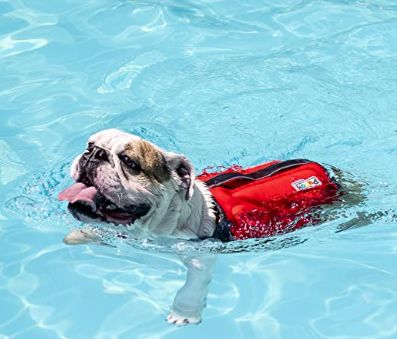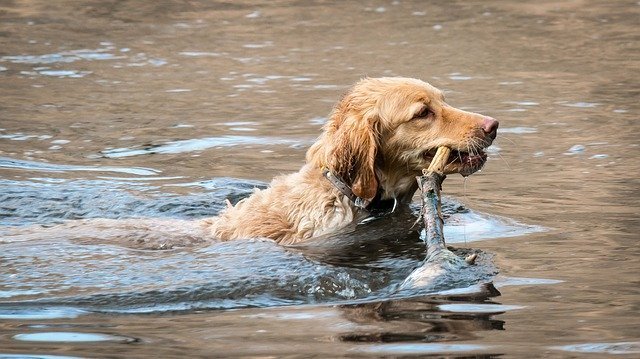You may be wondering – can dogs swim in lakes or is it best to keep them away?
It’s no secret that dogs love swimming.
However, while dogs aren’t aware of the dangers lurking beneath the surface, you are.
Can Dogs Swim in Lakes?
Before letting your dog swim in a lake:
- Make sure that your dog is a strong swimmer and accustomed to the water.
- Lake is full of dangers for your dog — blue-green algae, sand, rip currents, and fishing equipment is only some of them.
- Bring fresh water for your dog to drink and rinse its fur and ears after swimming.
- Consider buying a life jacket for your dog and carry a first aid kit.
- Examine your dog carefully when you return home for any ticks, thorns, or rashes.
Is Your Dog a Strong Swimmer?
Before you ask yourself, Can dogs swim in lakes?
make sure yours knows how to swim in general.
But wait, you might be thinking, aren’t dogs born with the ability to swim?
Unfortunately, no. Dogs are naturally better swimmers than we are and they learn much faster.
Also, when they find themselves in water, most dogs will start paddling right away — but that doesn’t mean they can stay afloat.
That’s why it would be good to give your dog some swimming lessons.
Start when it’s still a puppy — that way, it will quickly grow accustomed to the water. Make sure to do it somewhere safe and keep an eye on it.
A personal swimming pool is an ideal place to start, but if you don’t have one, beaches, lakes, and ponds will do.
Dangers of Swimming in Lakes
Once your dog feels comfortable and confident in the water, you can let it swim in a lake.
However, keep in mind that there are certain dangers in lakes — and your dog won’t instinctively avoid them.
So it’s up to you to learn what these hazards are and make sure your pup is safe.
Dry Drowning
There’s always a possibility, although a slim one, that your dog will get exhausted and drown while swimming.
However, since you’re monitoring it, you can recognize the signs of tiredness and call it to the shore.
Unfortunately, so-called dry drowning is more difficult to spot. It happens when water enters your dog’s lungs while swimming, but there are no symptoms right away.
Your dog can seem happy and healthy all day and only develop an infection or inflammation several days later.
It’s not just young dogs and novice swimmers who are in danger of dry drowning — dogs who swim regularly may swallow lots of water too.
The symptoms include coughing and hacking, difficulty breathing, and lethargy brought on by a lack of oxygen.
Blue-Green Algae
Stagnant and warm water is a perfect breeding ground for blue-green algae or cyanobacteria.
Usually, they give water a scummy, green hue, and a bad smell.
Sometimes, though, the algae can be present without any obvious signs, so it’s best to be careful around any still water.
Aside from being unpleasant to swim in, blue-green algae release toxins that are dangerous for both humans and animals.
However, dogs are particularly vulnerable — mostly because they play in the water and are more likely to ingest the toxins.
Symptoms of blue-green algae poisoning may appear 15 minutes after the ingestion, or after several days.
They include diarrhea and vomiting, drooling, weakness, seizures, and breathing difficulties.
As soon as you suspect your dog has been exposed to cyanobacteria, take it to a vet. Its toxins may lead to liver failure and are lethal to dogs.
Sand
You won’t find sand only on beaches — some lakes are also full of it. And, perhaps surprisingly, sand can be detrimental to your pup.
Of course, I don’t mean that just stepping on or playing in it could somehow hurt your dog.
But ingesting it can cause digestion problems and lead to organ rupture.
Basically, your dog can ingest sand from water or by licking its fur and paws. The send is quite heavy once it settles, and it does so rather quickly.
It may block your dog’s digestive system, causing it pain, vomiting, loss of appetite, and bloating. This condition, called intestinal sand impaction, has to be treated promptly.
So if you ever suspect your dog ingested too much sand, take it to a vet!
Dehydration and Heat Strokes
As strange as it may seem, your dog can dehydrate even when it’s near a large body of water. Due to the possible contaminants, you can’t let your dog drink lake water.
At the same time, though, it runs around, plays in the sun, and swims.
All of these activities require a lot of energy and heat your dog up. If you don’t pay attention, it can easily overheat.
Fishing Equipment
It might sound nice to sit by the lake and fish while your dog is swimming, but be careful. You don’t want to accidentally catch your pup!
Dogs are curious creatures, so they might want to investigate that bait just under the surface — and swallow it, along with the hook!
Usually, the worst that can happen is that your fishing hook gets embedded into your dog’s nose or tongue.
It’s not pleasant, but it’s nothing that a vet can’t fix.
However, if you’re using lead sinkers, be extra careful. If your dog swallows one (or many), it could cause lead poisoning.
Ultimately, if you know that your dog is of a mischievous kind, don’t take it along for fishing trips.
Make sure to keep an eye on it around other fishermen as well — no one wants their catch of the day to be a dog!
Rip Currents
Contrary to the popular belief, rip currents don’t only exist in the sea — large lakes with waves can also have them.
These currents run perpendicular to the shore and away from it, and they are strong enough to carry away people and animals, sometimes with tragic results.
Seeing your dog get carried away by a current may be traumatic, but don’t jump in after it. Rip currents are far more dangerous for people than dogs.
Generally speaking, dogs are stronger swimmers and less likely to panic, so they tend to ride it out and come back to the shore.
On the other hand, people who go after their dogs trying to save them often end up drowning.
Of course, while most dogs instinctively know how to deal with currents, some still do drown.
So to make sure that doesn’t happen to yours, learn how to spot a rip current and keep your dog away.
Can Dogs Swim in Lakes? — It’s Up to You
How can dogs swim in lakes when there are so many dangers on every corner?
After reading this, you may wish to never take your dog to a lake again.
But don’t worry — with a few precautions, your dog can swim in it as always.
Bring Water
But there’s a whole body of freshwater right there, you may say. Why would you bring more?
Well, because dogs shouldn’t drink lake water, just like you wouldn’t. I’ve already mentioned cyanobacteria, but there are other sorts of parasites, algae, and contaminants hiding in the lake.
So instead of risking it, bring some water for your dog too, and make sure to let it drink often. That way, you’ll avoid dehydration and heat strokes as well.
Consider a Dog Life Jacket
See our recommendation for a dog life jacket on Amazon.
Most dogs are strong enough swimmers that they don’t need a life jacket.

But if you’re worried about rip currents or you’re planning to go to the middle of the lake together, think about getting one.
Of course, you’ll need to help your dog grow accustomed to it before taking it to the lake.
Rinse Your Dog’s Fur and Ears
When you go swimming in a lake, you probably take a shower after you’re done. You do that to remove dirt, algae, and contaminants.
Similarly, if you want to keep your dog healthy, you should rinse it with clean water too.
Pay special attention to its ears — floppy ones, in particular, are quite prone to infections.
After you rinse them, make sure to dry them too, as any excess water could become a paradise for bacteria.
Carry a First Aid Kit
Your dog may step on some glass, hurt itself on fishing equipment, or get a thorn in its paw.
Either way, a first aid kit can really come in handy for these minor wounds.
And if you think it’s ridiculous to bring a first aid kit just for your dog, don’t forget that you might need it too.
Dog first-aid kit isn’t that much different from the one you’d use.
Examine Your Dog Carefully
When you come home after your fun day at the lake, brush your dog, and carefully examine it.
Look for hidden thorns, ticks, cuts, rashes, or any other issues.
If you notice something suspicious, take it to a vet. After all, better safe than sorry!
To Conclude
So can dogs swim in lakes? A simple answer is yes, they can, and since they like it so much, they should.
However, it’s up to you, as your dog’s owner, to make sure it steers clear of potential hazards.
Now you know some of the more common ones — so next time you visit a lake, both of you will have fun and be safe!


